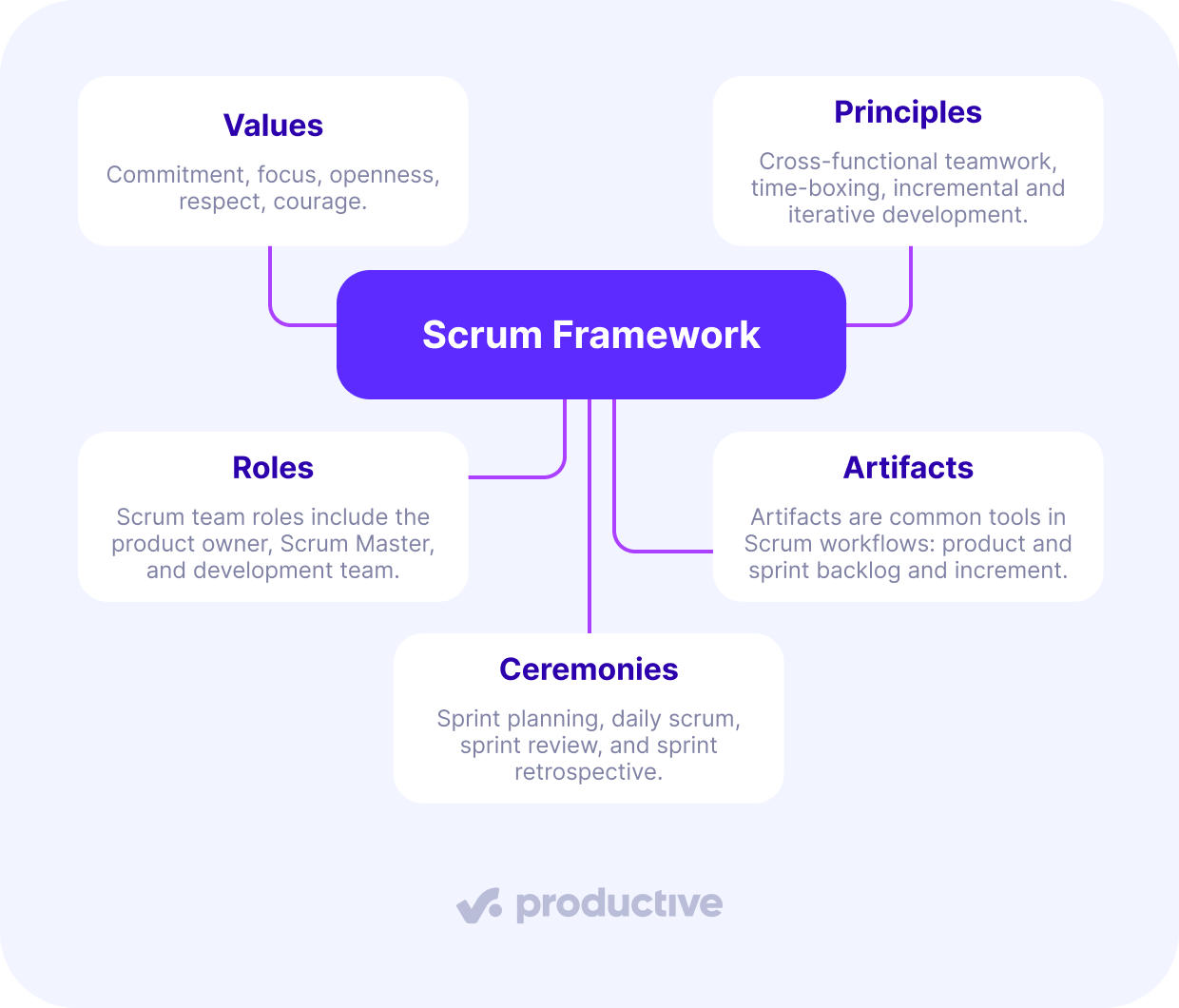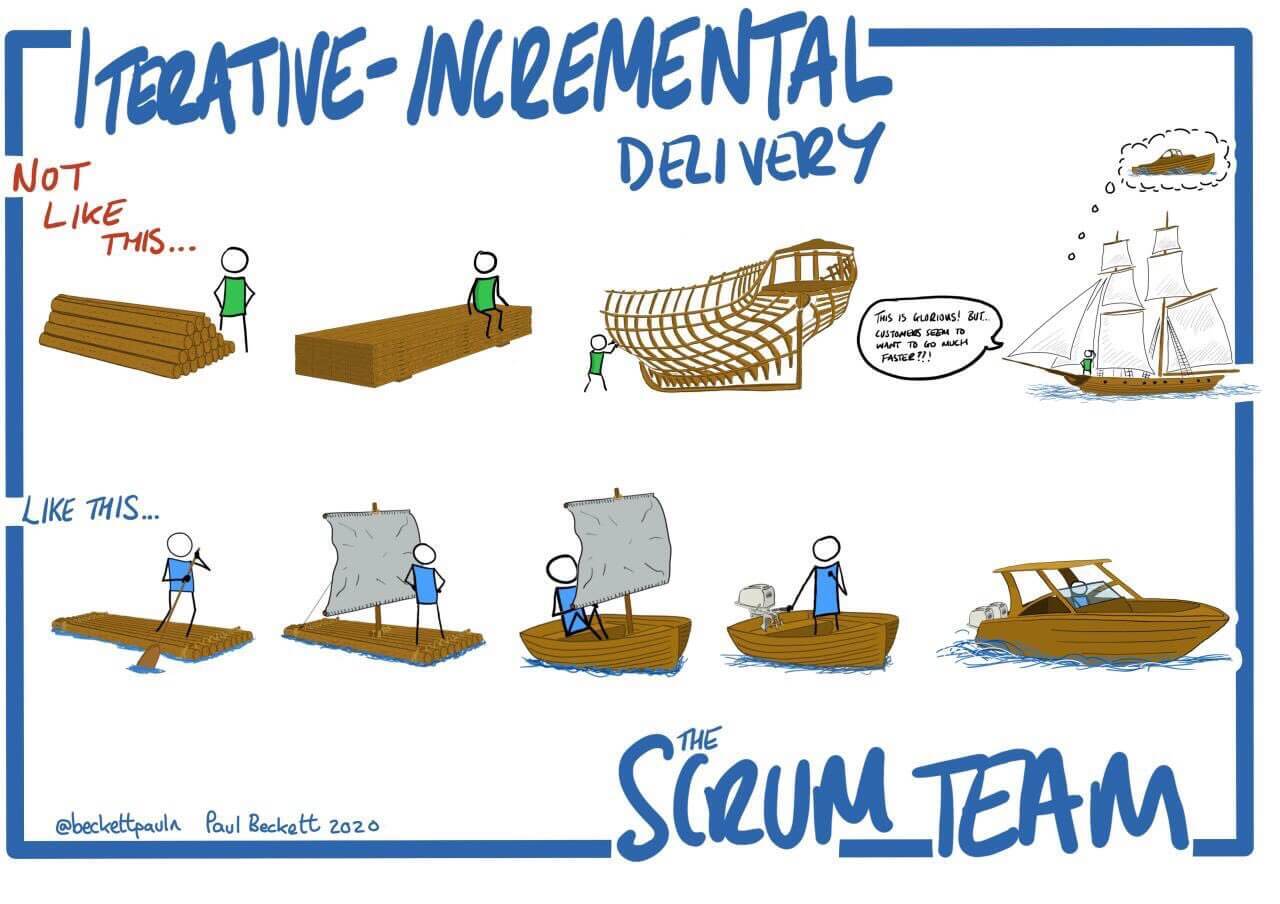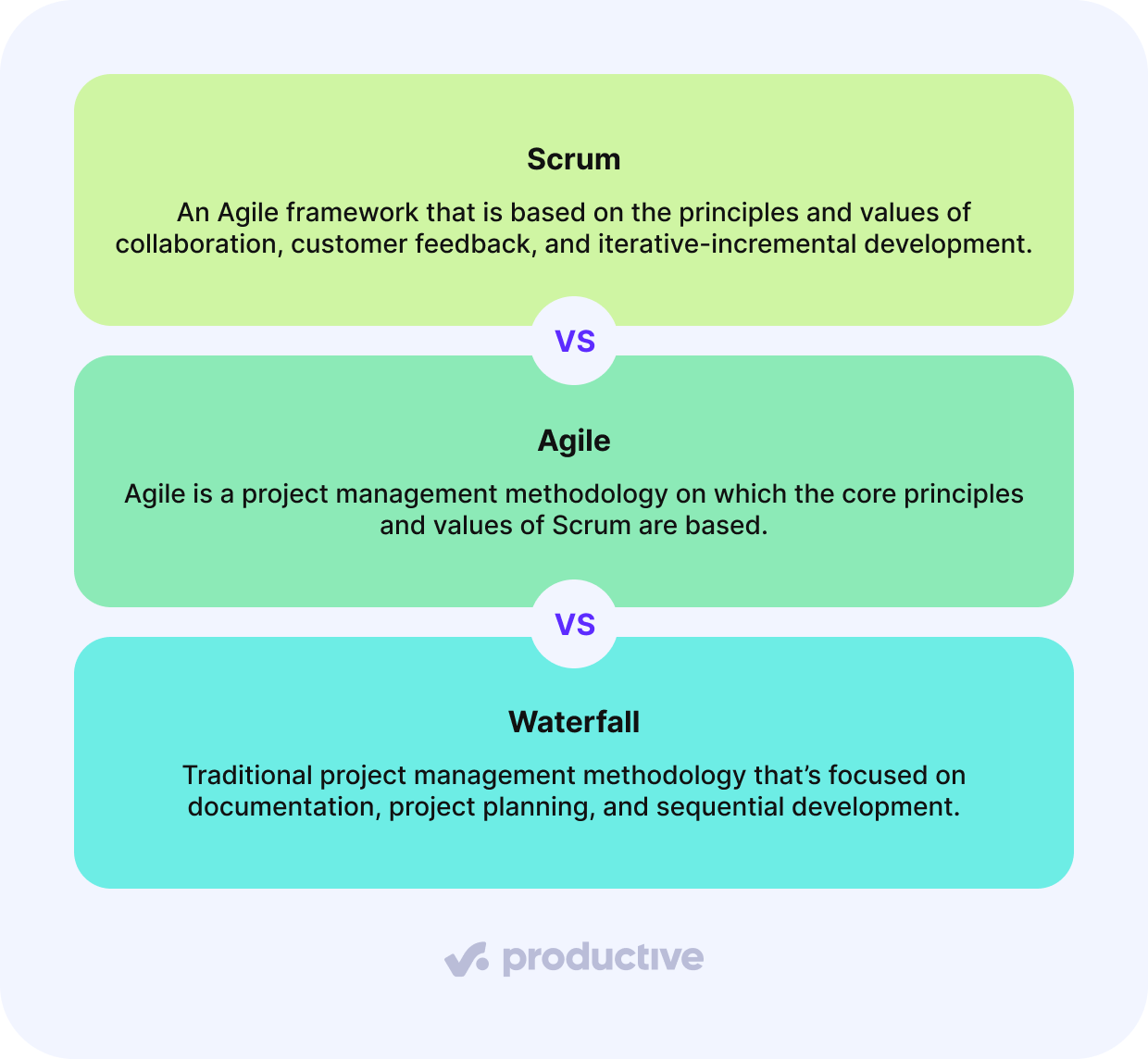Scrum Framework: Pillars, Principles, Best Practices
Scrum is an Agile framework that helps businesses of all shapes and sizes adapt to dynamic product requirements. In this article, we’ll discuss the Scrum framework basics: its values, principles, and practices, differences to other project management methodologies, and which businesses its best for.
Key Takeaways
- Scrum is an iterative and incremental framework based on the Agile methodology, which emphasizes collaboration and continuous improvement.
- Key roles include: the product owner, Scrum Master, and development team, each with specific responsibilities.
- Workflows are focused around sprints, with ceremonies like sprint planning, daily stand-ups, and retrospectives, which are organized to refine the backlog and monitor increments.
- Benefits include adaptability to change, better team collaboration, faster delivery of value, and continuous feedback for ongoing improvements.
What Is the Scrum Framework?
Scrum is an agile approach for software development teams, introduced by software developers Ken Schwaber and Jeff Sutherland in 1995.
Its history can be traced all the way to the 1980s, when an article was published in the Harvard Business Review, describing a scalable, team-based approach to project management.
Scrum’s basic principles and values are based on working in shorter sprints and delivering workable software in smaller increments.
This is based on the Agile manifesto—but what makes Scrum different from other Agile methodologies are its specific “artifacts” (or tools) and Scrum ceremonies used during project workflows.

We’ll discuss these Scrum fundamentals in more detail.
The Origin of the Name Explained
But first, you might be wondering—why Scrum? In the original paper from 1986, the authors Takeuchi and Nonaka used metaphors to describe product development.
Rugby was used to refer to a holistic approach that we recognize as Scrum, which is where the name comes from:
The . . . relay race approach to product development . . . may conflict with the goals of maximum speed and flexibility. Instead a holistic or “rugby” approach—where a team tries to go the distance as a unit, passing the ball back and forth—may better serve today’s competitive requirements.
Source: The New New Product Development game
Next, we’ll describe what this holistic approach means, through pillars, values, and principles.
What Are the 3 Pillars of Scrum?
There are three core pillars of Scrum, known also as the principles of empirical process control: transparency, inspection, and adaptation.
- Transparency: Makes both of the other principles possible. Transparency ensures that everyone involved has a clear understanding of the work, progress, and challenges. Without transparency, inspection and adaptation become ineffective.
- Inspection: Inspection involves examining and processing feedback. This step makes adaptation possible, since it allows teams to identify issues, inefficiencies, or changes needed to improve the product.
- Adaptation: In Scrum, it’s expected that requirements can’t be fully defined up front. The principle of adaptation allows staff to adjust their approach during development. However, there needs to be balance between adaptation and prediction to avoid chaos.
What Are the 5 Values of Scrum?
Scrum has five key values: commitment, focus, openness, respect, and courage. This shows Scrum’s focus on people-oriented development, where teams can work transparently and self-organize to deliver high-quality work.
- Commitment – Scrum team members are dedicated to achieving a common goal and take ownership of their work to deliver value
- Focus – Teams concentrate on the work planned for the sprint, avoiding distractions and ensuring steady progress toward the sprint goal
- Openness – Transparency is key, and team members openly share progress, challenges, and feedback to foster collaboration and continuous improvement
- Respect – Each team member’s contributions, perspectives, and expertise are valued, creating a supportive and inclusive work environment
- Courage – Teams embrace challenges, experiment with new ideas, and take bold steps to improve processes and deliver high-quality results
What Are the Main Principles of Scrum?
Scrum is built on core principles that align with the broader Agile Manifesto, emphasizing flexibility, team collaboration, and iterative progress.
The six key Scrum principles—empirical process control, self-organization, collaboration, value-based prioritization, time-boxing, and iterative development—are deeply connected to the Agile manifesto principles.
1. Empirical Process Control: Relies on transparency, inspection, and adaptation, allowing team members to learn from experience and continuously improve.
2. Self-Organization: Scrum teams are empowered to manage their own work, fostering creativity, accountability, and ownership.
3. Collaboration: Emphasizes cross-functional teamwork, stakeholder involvement, and continuous feedback.
4. Value-Based Prioritization: Ensures that teams deliver the most valuable work first to maximize customer satisfaction.
5. Time-Boxing: Scrum events (sprints, standup meeting, etc.) maintain a structured pace, ensuring productivity and predictability.
6. Iterative Development: Embraces a cyclical, iterative approach, allowing a team to refine products incrementally with each sprint.

source: Twitter
Overview of Main Practices: Roles, Artifacts, Ceremonies
Now that we’ve explored the similarities between the workflows of Scrum development teams and Agile teams, what are the differences?
While Scrum is a subset of Agile, there are key differences in how we understand them. Agile is a broad philosophy that emphasizes flexibility, collaboration, and continuous improvement, while Scrum is a specific framework that provides structure through defined practices, which includes roles, artifacts, and ceremonies.
These practices organize the workflows of product development teams, but they aren’t prescriptive for the most part. Teams are encouraged to take what works for them and modify what doesn’t.
First, let’s describe the basic practices of Scrum projects, starting with Scrum roles.
1. Roles and Responsibilities
Within the Scrum framework, each role has clearly defined responsibilities that contribute to the overall success of the project. The main roles of Scrum teams include the product owner, Scrum Master, and the development team.
The first two are strategic and interpersonal roles, while the development team brings the product idea to delivery. An effective Scrum team works together to achieve continuous improvement and implement customer feedback for a great end-result.
Product Owner
The product owner leads the product vision by deciding which features and functionalities should be included in the final result.
The product owner is also responsible for ensuring that they’re implemented in the right order, depending on their importance to the client and potential future users.
The role provides a point of contact between project stakeholders and development teams, and ensures that everyone has a clear vision during current and future sprints.
Scrum Master
The Scrum Master ensures that the entire team understands and works together according to Scrum values, principles, and practices.
Unlike a project manager, a professional Scrum Master is more of a leader than a manager. They provide support and coaching to the team and ensure that everyone can work productively without external or internal interferences.
In practice, this role often involves:
- Facilitating ceremonies such as daily meetings
- Resolving potential issues with third parties
- Coordinating priorities between multiple teams
- Keeping business professionals in sync with progress
Development Team
Finally, the development team is a collection of cross-functional professionals that work on designing, building, testing, and delivering a product.
The usual size of Scrum teams is up to nine people. Any more, and close-knit collaboration becomes more challenging. Scrum can and often is used in businesses with more developers; there, the standard practice is to break up teams into multiple units, all with their own Scrum Master and product owner.
These teams are also known as Scrum of Scrums, and work independently on specific aspects of a product, but align through regular coordination meetings to maintain a shared vision.
2. Artifacts
Scrum artifacts are key documents and tools that help teams stay organized, track progress, and ensure transparency in development. They provide a clear structure for planning, executing, and delivering work. The three main artifacts are the product backlog, sprint backlog, and increment.
- Product Backlog – A list of all tasks, features, and improvements needed for the product
- Sprint Backlog – A focused set of tasks selected from the product backlog to be completed in a sprint
- Increment – The working updates that meet the team’s quality standards and are ready for potential release
Product Backlog
The product backlog is usually created by the product owner. It’s a prioritized number of features needed to finish a product, developed through collaboration between the product owner and project stakeholders.
When developing a new product, product backlog items are usually new features and functionalities. For ongoing development or retainers, the backlog will often have improvements to existing features, bug fixes, and other incremental changes.
Backlog sprint items are refined and prioritized according to factors such as value, cost, and risk. The entire process of managing product backlog items is known as backlog grooming.
Sprint Backlog
The product backlog is almost always has more items than a team can realistically finalize. This is why these items are reviewed and selected during a sprint planning meeting.
The items that are expected to be accomplished during a single sprint are part of the sprint backlog. Items and priorities are flexible within the sprint, allowing adjustments as needed while staying aligned with the sprint goal.
The backlog serves as a focused to-do list, guiding daily work and ensuring steady progress toward a working increment.
Increment
An increment is the sum of all completed work at the end of a sprint that meets the Definition of Done. It represents a usable and potentially shippable version of the product. Each sprint should deliver at least one measurable improvement, contributing to the overall development.
For this to be valid, all work must be fully tested, meet quality standards, and be release-ready if needed. Even if deployment doesn’t happen immediately, ensuring each update is complete fosters continuous progress and transparency.
3. Ceremonies
Scrum ceremonies are structured meetings that help teams plan, track progress, and improve their workflow. These ceremonies ensure communication, alignment, and continuous improvement in each sprint.
The four key ceremonies are sprint planning, daily scrum, sprint review, and sprint retrospective:
- Sprint Planning – Defines the work for the upcoming sprint
- Daily Scrum – A short daily meeting to sync progress and plan the next steps
- Sprint Review – Demonstrates the completed work to stakeholders
- Sprint Retrospective – Evaluates the sprint process to identify improvements
Each ceremony serves a specific purpose; let’s examine them in more detail.
Sprint Planning
Sprint planning marks the start of a sprint, where the team decides what work will be completed. The product owner presents high-priority backlog items, and the team collaborates to select the most achievable tasks based on capacity.
The goal is to define a sprint backlog and establish a sprint goal—a clear objective for the sprint.
Effective planning prevents scope creep and ensures team alignment. A session typically lasts up to two hours per sprint week (e.g., a four-week sprint has an eight-hour planning session).
The session usually includes breaking down a product backlog item into tasks and determining whether it will fit within the sprint during the meeting.
Or, if the estimation process is more complicated, the development team can handle the task breakdown process alone and coordinates with the product owner.
Daily Scrum

Source: reddit
The daily scrum meeting, also know as a standup meeting (not to be confused with standup comedy), is a short, 15-minute meeting where the development team syncs up on progress.
Each team member briefly shares:
- What they completed since the last meeting
- What they plan to do before the next one
- Any blockers or challenges they are facing
The Scrum Master facilitates but does not lead; the team self-organizes. The focus is on coordination, not problem-solving—issues requiring deeper discussion are handled separately.
The meeting should be concise and focused and contribute to the shared goal of the sprint. If it becomes too long or repetitive, steps should be taken to turn the meeting back on track.
Sprint Review
The sprint review happens at the end of each sprint to showcase the completed work to the client. The development team presents the increment to stakeholders, including the product owner and other relevant parties.
Stakeholders provide feedback, which helps refine the product backlog and prioritize future work. This session is interactive—rather than just a presentation, it promotes discussions about improvements and upcoming priorities.
Its benefits are transparency and continuous alignment between the development team and business needs. If necessary, the product owner updates backlog priorities based on stakeholder insights.
This meeting typically lasts one to two hours depending on sprint length. The main goal is to assess progress, collect feedback, and ensure that all progress made is based on real user needs and business goals.
Sprint Retrospective
The sprint retrospective is the final ceremony. Unlike a sprint review, which examines the product, the sprint retrospective is an internal ceremony which looks at how the team worked together during the previous sprint.
The team reflects on what went well, what didn’t go well, and what can be improved. The idea of the meeting is to have an open, constructive discussion where actionable insights can be identified to improve future sprints.
A sprint retrospective typically lasts up to 90 minutes. One idea for how an effective sprint retrospective can be conducted to encourage conversation is to:
- Have the team to write at least 3 things that did or didn’t go well
- Group the notes on the wall without making any comments
- Vote silently on top three things to discuss, whether good or bad
This method encourages open and unbiased reflection by allowing the team focus on the most impactful topics without singling one individual out to provide (potentially negative) feedback.
Learn about the difference between a sprint retrospective and a project retrospective.
Key Benefits for Software Development
To summarize, here’s why Scrum can be such a great framework for software development:
- It helps teams handle complex projects while building high-quality software at a steady pace
- It encourages quick updates, learning from mistakes, and teamwork
- Keeps development on track with business goals with frequent progress checks
- Improves teamwork and responsibility by giving teams a clear but flexible way to work together
Because of this, Scrum is a great choice for software teams that need to move fast and deliver valuable products in a competitive market—nowadays, this basically goes for all teams.
However, Scrum can also be used in other industries. In the following section, we’ll provide an overview of a use case in the field of biotechnological research.
Case Study: Practical Example of Scrum Implementation
In the book Essential Scrum, Kenneth S. Rubin describes a personal account of a company he worked for, Genomica, switching over to the Scrum framework.
Genomica is a company specializing in discovery informatics platforms for research scientists.
According to Rubin, it faced significant challenges with its previous development approach. Their traditional, plan-driven methodology led to long delays, inefficient designs, and poor collaboration among teams.
Scrum was chosen becuase the team needed an approach that allowed for quick iteration, frequent feedback, and cross-functional collaboration.
Their product had to integrate seamlessly with a strategic corporate partner’s DNA sequencing technology, which required regular deliverables and validation.
The results speak for themself:
- Scrum required 10x less effort than Waterfall to develop comparable amount of product functionality
- Scrum development progressed at 7x velocity of Waterfall development
- The software was delivered within an expected time frame and strengthened Genomica’s partnership, increasing shareholder value
Scrum vs Agile vs Waterfall
As we mentioned previously, while Scrum shares similarities with other Agile methodologies, it has distinct characteristics that set it apart, such as specific ceremonies, practices, and clearly defined roles.
In contrast to traditional project management approaches like Waterfall, Scrum offers greater flexibility, adaptability, and opportunities for client involvement throughout development.
Traditional project management is usually more rigid, focused on documentation, and in-depth project planning. This can be good for projects with repetitive processes, but less so if the development requires innovation.
However, implementing Scrum effectively requires a dedication to embracing its values and priniciples and training and hiring of specialized staff to ensure implementation is proceeding smoothly.
Is Scrum a Framework or a Methodology?
This is a popular question, and it can be a cause for some confusion.
Essentially, Scrum is a framework, not a methodology, because it provides a flexible structure for teams to collaborate, inspect, and adapt rather than prescribing a rigid set of step-by-step instructions.
A methodology is a detailed, predefined approach that must be followed exactly, whereas Scrum offers guidelines, roles, events, and artifacts that teams can adapt to their specific needs.
However, you might also see Scrum referred to as an Agile methodology in some resources, usually to avoid going into these distinctions.

Which Businesses Is Scrum Suitable for?
While Scrum was developed in the context of software development projects, the Scrum process can and is successfully applied to other industries.
This is because its core values and principles (of collaboration, progress checks, and time-boxed development) are suitable to various types of projects, such as marketing project management, design, product development, and so on.
Instead of industry, there are other characteristics that make businesses suited to using the framework:
- Projects that are highly innovative and experimental, and traditional and structured approaches can’t be easily applied
- When project goals, customer needs, or market conditions are constantly evolving, an adaptive approach helps team members adjust efficiently
- Scrum thrives in environments where diverse skill sets need to work together to deliver value
When to Choose a Different Project Management Methodology?
While Scrum is very useful and widely applicable, it’s not a miracle solution. There are projects and businesses where it won’t be the best option.
However, there are other non-Agile and Agile project management frameworks to consider.
For example:
- If you’re struggling with process optimization, a data-oriented approach like Six Sigma project management can be useful
- When priorities are constantly changing and sprints can’t be reliably planned, using Kanban as a standalone or alongside Scrum can help organize and visualize WIPs
- For businesses with simple, repeatable workflows, a traditional project management methodology like Waterfall can provide a reliable and linear approach
Practical Adoption Guide
After learning all of the basics of Scrum and when it’s best applied, if you’re still set on implementation in your business, here’s some practical advice:
- While it’s often recommended to modify parts of Scrum for your needs, it’s first necessary to understand its principles and values—otherwise, your modifications can lead you astray.
- Give people time to adjust to changes in your processes. Scrum requires an extensive shift in mindset, and this won’t happen over night. A window of three to six months is average for a Scrum implementation.
- Don’t try to adopt Scrum in the middle of an existing project, as this will usually lead to more delays and chaos. Save it for a new project to ensure all principles are in place without dealing with the pressures of in-progress development.
- Ensure that some time is allocated for continuous improvement. Businesses sometimes skip out on daily standups or retrospectives, finding them a waste of time. However, learning is one of the core values of Scrum, and should be implemented in some form.
Advanced Implementations
While this article is focused mainly on basics, there are some advanced Scrum implementations that adapt it to a complex project, a large team, or unique business needs.
Techniques like Scaled Scrum frameworks (e.g., SAFe, LeSS, Nexus) help coordinate multiple Scrum teams working on the same product.
Organizations may also refine backlog management with dual-track Scrum, introduce Kanban-Scrum hybrids for continuous delivery, or enhance sprint reviews with customer-driven validation.
Hybrid PM combines elements from Scrum/Kanban/Lean with Waterfall – read how it works in our guide to hybrid project management.
By tailoring Scrum practices, companies can apply its core values and principles in large-scale or highly dynamic environments.
Support Your Process With Software
To summarize, Scrum is an approach that can be highly effective for a variety of industries, but it requires a basic understanding of its rules and structures.
Learn how to best organize your team, encourage an Agile mindset, and implement crucial artifacts and ceremonies to ensure effective project management.
All Scrum professionals also need a software solution to complement their processes. A project management software solution that supports task management, capacity planning, and even project budgeting can be a bit asset to your organization.
Book a demo with Productive to learn more.
Keep Projects on Time and Budget With Productive
Switch from multiple tools and spreadsheets to an all-in-one platform for project management, resource planning, and financial management.
